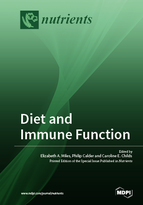Diet and Immune Function
A special issue of Nutrients (ISSN 2072-6643).
Deadline for manuscript submissions: closed (30 September 2018) | Viewed by 377792
Special Issue Editors
2. NIHR Southampton Biomedical Research Centre, University Hospital Southampton NHS Foundation Trust and University of Southampton, Southampton SO16 6YD, UK
Interests: nutrition; immunity and inflammation; metabolism; handling and functionality of fatty acids, especially omega-3 fatty acids
Special Issues, Collections and Topics in MDPI journals
Special Issue Information
Dear Colleagues,
Supporting initiation, development and resolution of appropriate immune responses is key to survival. Many nutrients and dietary components have been purported to have a role in supporting optimal immune function. This is vital throughout the life course, from the development and programming of the immune system in early life, to supporting immunity and reducing chronic inflammation in older people. In this special issue of Nutrients, we examine the evidence for the role of diet and dietary components in promoting protective immunity.
Dr. Elizabeth A MilesProf. Philip Calder
Dr. Caroline E Childs
Guest Editors
Manuscript Submission Information
Manuscripts should be submitted online at www.mdpi.com by registering and logging in to this website. Once you are registered, click here to go to the submission form. Manuscripts can be submitted until the deadline. All submissions that pass pre-check are peer-reviewed. Accepted papers will be published continuously in the journal (as soon as accepted) and will be listed together on the special issue website. Research articles, review articles as well as short communications are invited. For planned papers, a title and short abstract (about 100 words) can be sent to the Editorial Office for announcement on this website.
Submitted manuscripts should not have been published previously, nor be under consideration for publication elsewhere (except conference proceedings papers). All manuscripts are thoroughly refereed through a single-blind peer-review process. A guide for authors and other relevant information for submission of manuscripts is available on the Instructions for Authors page. Nutrients is an international peer-reviewed open access semimonthly journal published by MDPI.
Please visit the Instructions for Authors page before submitting a manuscript. The Article Processing Charge (APC) for publication in this open access journal is 2900 CHF (Swiss Francs). Submitted papers should be well formatted and use good English. Authors may use MDPI's English editing service prior to publication or during author revisions.
Keywords
- diet
- immune function
- immunity
- inflammation
- micronutrients
- nutrients
- prebiotics
- vitamin







